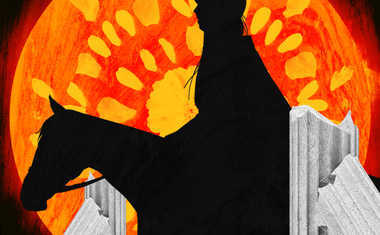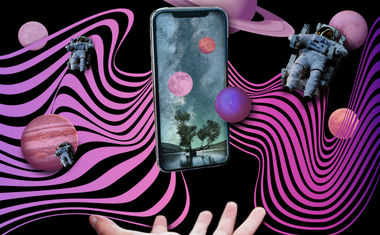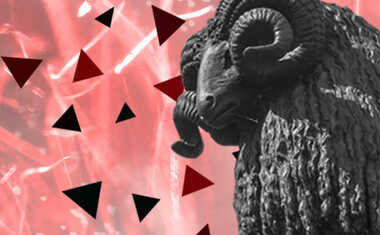
The Major Arcana: Fool's Journey
An essay on how the Fool came to be
Modern interpreters sometimes refer to the Tarot majors as the Fool's Journey. The 21 images of the trumps are seen as stages in a psychological or mystical journey and the Fool is seen as the pilgrim. Is this interpretation the result of modern imagination stoked by Jungian psychology? Is the Fool's Journey merely an occultist fable?
The purpose of this essay is to address these questions. Specifically, the objective is to examine whether the ordinary card-player in 15/16th century Italy would have seen the trumps as a Fool's Journey. As the evidence accumulates, the sceptic may be surprised to find that this is, in fact, possible.
The prima facie evidence is the availability and popularity of the venacular classics of Dante and Petrarch. Dante's 'Divine Comedy' is unambiguously a mystical journey and incorporates at least 19 of the 22 Tarot symbols. Petrarch's 'I Trionfi' shows many connections to the Tarot (Moakley 1966) and describes the poet's own psychological development from sexual infatuation to Beatific Vision (Carnelli 1971). Handpainted manuscripts of these epics may have been the exclusive property of the aristocracy and wealthy merchants, but the poetry itself was the proud possession of every Italian, sung by blacksmith and drover (Larner 1971).
However, the popular poetry of Dante is only the surface. The visionary voyage/pilgrimage/journey is an integral part of the Western experience. Indeed, our earliest written story (~1600 BCE), the cuneiform 'Epic of Gilgamesh' (Kovacs 1990), relates just such a journey (Zaleski 1971). We will find that the mystical 'other worldly' journey is a persistent theme throughout the history of Western culture.
Please permit me to pause briefly and acknowledge that the visionary journey is not the exclusive property of the West. The mystic journey occurs in Taoist, Buddhist, Brahman, Persian, Egyptian, Judaic and Christian traditions (Gardiner 1989). I have been honored to hear the Hawaiian legend of the fire goddess Pele's journey into hell to rescue her kidnapped sister. Stories of otherworldly journeys are common to shamans in Oceania, Siberia, Korea, Japan, South America, and among the Inuits of North America (Couliano 1991). Mystical journeys through the 9 heavens on dragons or birds are found in China. The Indian Vedic hymns speak of mystical ascents. In Tibet, the journey of the dead soul is an essential element of religious literature (Fremantle and Trungpa 1975).
There is nothing to indicate that the tales of spiritual journeys in Hawaii or Japan had any influence on the Tarot. But the broad, cross-cultural basis of these stories is Jung's primary criterion for archetypal material. Jung (1956) deals with such stories under the rubric of the "Hero's Journey". So, if one accepts Jung's concept of the archetype, then the Fool's Journey is a mythic theme available to all times and cultures. Indeed, modern accounts of near-death experiences (Corcoran 1996) seem to belong to the same archetypic tradition.
However, our objective relates specifically to the early Tarot and the mystical journey tradition in the West. So we must next turn our attention to the early Egyptian texts on the soul's journey after death (Budge 1901, 1920, Morenz 1960). The early dynastic Pyramid texts talk about the soul's ascent step by step up a ladder. The intermediate Coffin texts indicate that the soul must overcome obstacles on the ascent. The later Book of the Dead discusses the weighing of the soul and the need for passwords and magic spells at various stages of the journey. We should also mention in passing a 7th century BCE Akkadian text on Kummaya's journey to netherworld (Collins and Fishbane 1995). These ancient texts were not available when the Tarot was designed in 15th century Italy. But the Egyptian and Akkadian texts reveal the deep roots of the versions that were known to the card-players.
From these Egyptian texts, let us pass to the Greco-Roman tradition (Couliano 1991). There are examples of otherworldly journeys in both Homer's Odyssey and Virgil's Aeneid. Plato's Republic (~375 BCE) discusses the journey of the soul in the afterlife before its rebirth (Haas 2000). Cicero records the visionary journey of Scipio (106-43 BCE). Silius Italicus records the visionary journey of Punica. Plutarch (50-120 CE) tells of the journey of Aridaios. The journey of Apolonius is recorded sometime before 217 CE. Plotinus (205-270 CE) equates these mythic visions to the mysticism of the individual soul's journey back to the One. Proclus discusses the descent and subsequent ascent through the spheres. And although the direct evidence is sparse, it appears that the Mystery Religions involved simulated passage upward through the planetary spheres. The Mitraic initiate descended downward to a conversion deep within and then passed through 7 stages from darkness to light (Zaleski 1987). Once again, these Greco-Roman texts and mysteries were not all available in early 15th century Italy. But they indicate the direct transmission of older traditions and the persistent appeal of the journey theme in Western consciousness.
Parallel to the Greco-Roman tradition was a developing Judeo-Gnostic-Christian tradition. During the period from the 3rd century BCE to the 2nd century CE, an impressive literature developed in which the visionary is taken on a mystical journey (Collins 1989). In addition to the canonical accounts of Daniel and Ezechial there are more than 20 other examples. The following is a list compiled from Doresse (1960), Couliano (1991), Himmelfarb (1993), and Collins (2000):
Book of the Watchers (1 Enoch 1-36)
Testament of Levi
2 Enoch
Similitudes of Enoch (1 Enoch 37-71)
Apocalypse of Zephaniah
Apocalypse of Abraham
Ascension of Isaiah
3 Baruch
Hekhalot Rabbati
Merkaba Rabba
3 Enoch
Apocalypse of Elijah
Chronicles of Jerahmeel
Revelations of Joshua ben Levi
Ascension of Moses
Apocalypse of Esdras
Apocalypse of the Virgin Mary
The Story of Zosimus
Apocalypse of the Holy Mother of God
Apocalypse of James
Mysteries of St John the Apostle and the Holy Virgin
The Book of Resurrection
Apocalypse of Sedrach
Paraphrasis of Seem
Zostrianos
Two Books of Ieu.
I thank the readers for their patience in allowing me to establish the historical foundations underpinning the visionary mystical vision. The details of the individual accounts are not relevant since it is a reasonable assumption that the texts themselves were unknown to the 15th century tarot card-player. But the sheer volume of the early tradition shows the deep well from which the early Christian mystical literature drew its material.
It is the Christian accounts of the mystical journey that are most relevant to our objectives. Modern Tarotists may be unfamiliar with this literature and once again I beg your indulgence while I establish just how extensive this literature was. Not a century of the Common Era passes without one or more examples (There are also some additional visions for which I could find no date: Walkelin, Voyage of Bran, Louis of France, Monk of Savigny, The Precious Pearl.). The following list is mostly from Gardiner (1989):
0-100
St. Paul (2Corinthians 12, Galatians 1, see Segal 1995)
100-200
Apocalypse of St. Peter
The Shephard of Hermas
200-300
The Martyrdom of Perpetua
300-400
Apocalypse of St. Paul
400-500
St Brendan's voyage
500-600
Abbot Sunniulfus of Randan (Couliano 1991)
Three visions from Gregory the Great
Salvius
600-700
Furseus the Irishman (Couliano 1991)
Drythelm of Cunningham (Coulinano 1991)
St. Fursa (Zaleski 1987)
Baldarius
Visio Baronti
Bonellus
Drythelm's vision
Maximus
700-800
Vision of Adamnan
Monk of Wenlock
Barontus
800-900
Bernoldus
Wetti's vision
English Priest
Poor woman
Charles the Fat's vision
Raduin
Rotcharius
St. Ansgar
900-1000
Vision of an English man
Laisren
Ansellus Scholasticus
1000-1100
Heriger
Leofric
1100-1200
Vision of knight Owen
Tundale's vision
Monk of Evesham's vision;
Gottschalk
Vision of Alberic
Boy William
Gunthem
Monk of Melrose
Orm
1200-1300
Thurkill's vision
English Novice
Olav Asteson
1300-1400
Dante
1400-1500
Lazarus
William Staunton
The number of examples in European literature is impressive. However, the ubiquity of the stories means little if the 15th century card-player knew nothing of these visionary journeys. But that is not the case. "Otherworldly narratives are one of the most popular and fascinating types of medieval literature" (Gurevich 1988, p. 109). And again, "These visions were extremely popular literary works" (Gardiner 1989, p. xiii). Tundale's journey, for example, was available in at least 13 languages by the end of the 14th century (Gardiner 1989). Over 200 manuscripts of this vision have survived (Haas 2000).
The popularity and availability of this literature is easily explained. They were preserved by the Church as moral allegories useful for preaching (Gardiner 1989). As such, they were actively preserved in the monastery scriptoria and widely disseminated. The stories were told and re-told throughout Europe. It is reasonable to assume that the 15th century card-player had been exposed to one or more of the stories.
It is also important for the modern Tarotist to realize that these experiences were not presented as fiction. Like Dante, many of the journeyers insist that they are relating an actual experience and that they, like the author of Revelations, were instructed to communicate what they had experienced. The Christian accounts are not merely visionary experiences. The journeyers relate experiences of smells, heat, and pain. Eyewitnesses attested that the journeyer returned with burn scars from their experience of the underworld.
Whether or not the eyewitness accounts could stand up under the critical cross-examination of a modern sceptic is beside the point. The modern sceptic does not believe in griffons and unicorns either, but the 15th century card-player probably did. So the important point is that the card-player likely accepted the miraculous accounts as actual experience. This was an age of belief. Magic and miracles and spiritual journeys were as real and familiar as bread and ale.
But if the reader is now ready to accept that the mystical journey was known and accepted by the early 15th century, it remains to ask whether the card-player would have recognized these popular accounts in the Tarot Trumps. This is, in fact, the crux of this essay and we must weigh the evidence carefully, both pro and con.
The lowest numbered cards do not seem to be derived from the traditional mystical journey. The Bagatto (the original version of the Magician card) does not appear in the "otherworldly journeys" If Moakley (1966) is correct that this card represents the guide - the instructor, protector, soul-taker - then perhaps this street magician is represented because the stories almost always include a guide (Zaleski 1987). But this is a stretch and there does not seem to be any firm evidence that the card-player would have recognized the Bagatto from the stories of the otherworldly journeys. Similarly, the Papess and Empress do not seem to be represented in the traditional literature. We will have to seek other sources for these first few symbols.
On the other hand, the voyager in the Christian tradition often encounters members of the "estates of man". The Visio Bernoldi reports seeing bishops and Charles the Bald in hell (Haas 2000). Thurkill meets priests, knights, judges and merchants (Haas 2000). Tundale sees a king on a throne (Gardiner 1989). Thus, rulers and clerics appear even if the Emperor and Pope play a less prominent role than in Dante's 14th century Divine Comedy. So we may conclude that the card-player might possibly have recognized the early cards as representing the estates of man. But the evidence is weak for all of the low-numbered cards.
The evidence only begins to become interesting with the intermediate cards. Tundale's vision reserves a special place in the afterlife for the Lovers, the "Blessed Married". The image of the Chariot would have been familiar from Ezechial's vision. The image of Justice, as the weighing of the soul, dates back to the Egyptian texts. But since these texts were unavailable in the early 15th century, it is more relevant to note the image of Justice, complete with scales, in Thurkill's familiar vision. The image of the Hermit might also have been recognized as it appears in St. Brendan's voyage and also in Tundale's vision. Thus, the cards numbered VI to IX in the Tarot de Marseille appear explicitly in the traditional visions.
But, as with the early cards, there is then a gap. Outside of Dante, I have been unable to find a direct reference to the Wheel of Fortune, the virtues Fortitude and Temperance or the Hangedman. Once again we must conclude that the early card-players would not have associated these symbols with the mystical voyages that they had heard lauded from the pulpit.
Indeed, a major finding of this study would have to be that the ordinary card-player would not likely have associated the early cards with the "Fool's Journey" theme. The source of the card-players association could well have been through Dante, who presents these images more explicitly. But only weak evidence can be offered that the first half of the Trump cards would have had an immediate association with the voyage theme.
The situation is quite different with the higher Trump cards. The Apocalypse of Abraham presents the archetypal Death disguised as an archangel. Death also appears in Tundale's vision. The Devil appears explicitly in Drythelm's and Tundale's vision. The Tower, complete with destruction and smoke, occurs in Wetti's vision. The theme of increasing light (Star/Moon/Sun) is quite common and appears in the Apocalypse of Paul, Drythelm's vision and in the account of the Monk of Evesham. An explicit listing of Star, then Moon, then Sun can be found in an Iranian account (Viraz, 6th century CE.). The theme of the resurrection and final judgment occurs throughout these stories (Gurevich 1988). The judgment is discussed, for example, in St. Brendan's voyage, Wetti's vision, the Apocalypse of Paul, and the Apocalypse of St. Peter.
The 15th and 16th century World cards shows a figure, such as an angel, holding up a sphere containing the "New Jerusalem". A common conclusion of many of the otherworldly journeys is a vision of heaven as the New Jerusalem (Haas 2000). It is found, for example, in Drythelm's vision, the Monk of Evesham's vision and the Apocalypse of St, Peter. Indeed, the vision of the New Jerusalem may be the most common element across all of the journey literature (Gardiner 1989). New Jerusalem as the goal of the journey remains even when the religious quest becomes associated with the romanic quest in the Grail legends (Emmerson 2000).
The familiar World image with female figure and the four beasts does not occur in the surviving early Tarot decks. However, this symbol appears in all of the Tarot decks in subsequent centuries. The transition from the New Jerusalem to the female figure is interesting because Himmelfarb (1993) points out that the true goal of the journeys in the Judaic literature is wisdom. The goal of the journey as Wisdom/Gnosis/Sophia may be a Judaic concept with its source in the Old Testament Wisdom literature, such as Proverbs (von Rad 1973). Thus, the transition of the World card from the New Jerusalem to an image of Wisdom may reflect the increasing influence of the Christian Cabalists of the later 15th century.
The Fool does not appear expicitly in the journey literature. However, the pilgrim often takes on properties that are associated with the medieval Fool. The visionary assumes the role of a "...child, not yet contaminated, the soul essentially stripped of status...it lacks a social identity...leaving behind the insignia of earthly status"(Zaleski 1987). The visionary as Fool may be clearer in the Judaic literature where the goal is Wisdom (von Rad 1973). For example, (Proverbs 26.12) "Do you see a man who thinks he is wise?\There is more hope for a fool than for him" and again (Proverbs 28:26) " He who trusts in himself is a fool, but he who walks in wisdom escapes." Thus, the evidence that the card-player would have recognized the Fool as the journeyer is cicumstantial. Certainly, the early card was not labelled "Tundale".
In summary, we can say that there was a long tradition of the mystical journey in the cultural milieu of the 15th century card-player. The stories were popular and widely used as material in preaching. There is a relationship between the elements in the mystical journeys and the Tarot symbol, particularly the second half of the trumps. But the evidence is far from overwhelming. So while it is not outlandish to hypothesize that the journey literature had some influence, it seems far more likely that it was Dante's Divine Comedy that was the immediate influence.
But I would be remiss if I did not include in this survey two other potential sources of the journey literature: Sufism and the Grail legends. Sufism, like Judaism and Christianity, developed and preserved a literature on the mystical journey, the mi'raj or night journey of Mohammed. One commentator (839-923 CE) collected 26 traditions. These became popular Sufi legends and were available in Latin probably from the 13th century (Couliano 1991). In parallel with the Christian tradition, the Sufi literature equates the stages of the mi'raj with stages of the mystical journey. However, the specifics of the night journey do not correlate well with the Tarot symbols which appear to be more closely related to the Judeo-Christian tradition of otherworldly journeys.
Another version of the journey literature became incorporated in the Grail legend. In these popular stories, the 'otherworldly' journey becomes an individual's psychological and magical quest. Some modern intereptors have jumped to the conclusion that the Tarot is directly derived from these legends, but this is unlikely. It seems far more likely that they have a common source in the collection of archetypic visionary journeys that go back for millenia. If there was an influence, it was likely to have been an indirect one through Dante's familiarity with the troubadours. However, because of the popularity of this theory of origins, we will address it in more detail in a future essay.
In conclusion, there existed at the time of the Tarot's origins a rich tradition of visionary journeys. The readily available stories were Christian and commonly used as examples in sermons. It is reasonable to assume that the 15th century card-player was familiar with the concept and with at least some details of the stories. The evidence unearthed by modern scholarship, cited in this essay, indicates that the Fool's Journey is not an occult fable but a popular account of spirituality at the time of the Tarot's origin. What is more interesting is that it was a completely orthodox belief, forstered and disseminated by the Church.
At the same time, the evidence that we have examined does not make a convincing case that the Tarot was directly derived from this source. The symbols in some of the higher trumps appear in these stories, but certainly not all of the Tarot symbols and seldom in the right order. Strong evidence exists only for the correlations of the trumps with Dante's Divine Comedy, the culmination and greatest of the journey epics.
The evidence for correlations between the trumps and the Divine Comedy are addressed in a separate essay. Thus, it appears to be through Dante that the journey literature influenced the Tarot. And it can be argued that familiarity with the imagery in Dante would have led at least some card-players to see the Fool's journey in the cards.
References
Becker, E. J. 1899. A contribution to the comparative study of the Medieval visions of heaven and hell. John Murphy, Baltimore, MD.
Betts, H. D. 1986. The Greek magical papyri in translation. University of Chicago Press, Chicago.
Budge, E. A. W. 1901. Egyptian magic. (reprinted 1971, Dover Books, NY).
Budge, E. A. W. 1920. The Book of the dead. (reprinted 1960, University Books, NY)
Carnelli, D. D. 1971. Lord Morley's Tryumphes of Fraunces Petrarcke. Harvard University Press, Cambridge, MA.
Collins, A. Y. 2000. Cosmology and Escatology in Jewish and Christian apocalypticism. Brill, Boston.
Collins, J. J. 1989. The Apocalyptic Imagination: An introduction to the Jewish matrix of Christianity. Crossroads Publishing, NY.
Collins, J. J. and M. Fishbane (eds.) 1995. Death, ecstacy and other worldly journeys. State University of New York Press, Albany, NY
Corcoran, D. K. 1996. When ego dies: a compilation of near-death and mystical conversion experiences. Emerald Ink, Houston, TX.
Couliano, I. P. 1991. Out of this world; otherworldly journeys from Gilgamesh to Albert Einstein. Shambala, Boston.
Dods, M. 1902. Forerunners of Dante. Edinburgh.
Doresse, J. 1960. The secret books of the Egyptian gnostics. Hollis and Carter, London.
De Lubac, H. 1981. Exegese medievale. Aubier, Paris
Emmerson, R. K. 1981. Antichrist in the middle ages. University of Washington Press, Seattle, WA.
Emmerson, R. K. 2000. Apocalyptic themes and imagery in Medieval and Renaissance literature. Pp. 402-441 In B. McGinn (ed.) Encyclopedia of Apocalypticism. Vol. 2. Apocalypticism in western history and culture. Continuum, NY.
Fremantle, F. and C. Trungpa. 1975. The Tibetan book of the dead. Shambala, boulder, CO.
Gardiner, E. (ed.) 1989. Visions of Heaven and hell before Dante. Italica Press, NY.
Gurevich, A. 1988. Medieval popular culture: Problems of belief and perception. Cambridge University Press, Cambridge.
Haas, A. M. 2000. Otherworldly jouneys in the Middle Ages. Pp 442-466. In B. McGinn (ed.) Encyclopedia of Apocalypticism. Vol. 2. Apocalypticism in western history and culture. Continuum, NY.
Himmelfarb, M. 1985. Tours of hell: and apocalyptic form in Jewish and Christian literature. University of Pennsylvania Press, Philadelphia, PA.
Himmelfarb, M. 1993. Ascent to heaven in Jewish and Christian Apocalypses. Oxford University Press, NY.
Idel, M. 1995. PaRDeS: some reflections on Kabbalistic hermeneutics. Pp. 249-268. In Collins, J. J. and M. Fishbane (eds.) 1995. Death, ecstacy and other worldly journeys. State University of New York Press, Albany, NY.
Jung, C. G. 1956 Symbols of Transformation. Princeton University Press, Princeton, NJ.
Kovacs, M. G. (trans.) 1990. The Epic of Gilgamesh. Stanford University Press, Stanford, CA.
Larner, J. 1971. Culture and Society in Italy 1290-1420. Charles Scribner, NY.
McGinn, B. 1994. Antichrist: two thousand years of the human fascination with evil. Harper-Collins, San Francisco, CA.
Moakley, G. 1966. The Tarot Cards. New York Public Library, NY.
Morenz, S. 1960. Egyptian Religion. (trans 1973, Cornell Univeristy Press, Ithaca, NY).
Segal, A. F. 1995. Paul and the beginning of Jewish mysticism. Pp 95-122 in Collins, J. J. and M. Fishbane (eds.) Death, ecstacy and other worldly journeys. State University of New York Press, Albany, NY
Smith, F. S. 1986. Secular and sacred visionaries in the late middle ages. Garland, NY.
Von Rad, G. 1973. Wisdom in Israel. Abingdon Press, NY
Wood, R. C. and J. E. Collins (eds.) 1988. Civil religion and transcendental experience. Merce Univeristy Press, Macon, GA.
Zaleski, C. 1987. Otherworld Journeys. Oxford University Press, NY.



